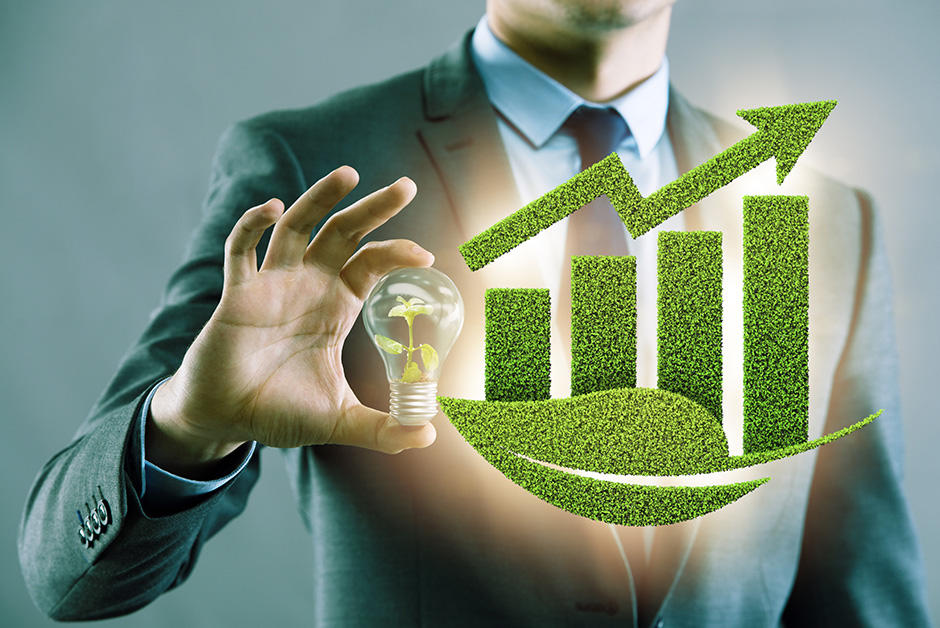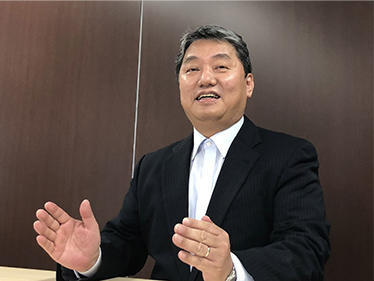
Efforts to rein in net greenhouse gas emissions to zero and bring about a carbon-free society are accelerating in nations throughout the world in a bid to prevent global warming. The japanese government's pledge to be carbon neutral by 2050 is but one example. Companies also are actively pushing reduction of greenhouse gases as a way to counter climate change and its threat to the sustainability of their business endeavors. Here, we will be looking at the initiatives that OMRON is pushing to achieve both business growth and a reduction in greenhouse gas emissions.
Did you know how much CO2 is globally produced in a year?
About 33 billion metric tons. This figure doubled in under 50 years. The average global temperature rose by 0.86┬║C during this time, and it is continuing to rise even now. Consequently, international organizations, national governments, and more have flagged the reduction of CO2 and other greenhouse gas emissions as an issue that requires a solution.
For example, China announced that it would reduce CO2 emissions to virtually zero by 2060 at a United Nations General Assembly in September 2020. Japan has similarly pledged to be carbon neutral by 2050, and it is accelerating initiatives to realize a carbon-free society. It has set concrete targets in 14 areas. For example, it is asking that all new passenger cars sold be electric vehicles by the mid 2030s.
Companies are also making efforts to reduce CO2 emissions because global warming and the accompanying climate change threaten the sustainability of future business activities. Typical efforts include the installation of solar and biomass power generation systems at their facilities and procurement of electricity derived from renewable energy sources.
ŃĆĆ
At OMRON, we believe that creating an environmentally sustainable society is an extension of the OMRON Principles of improving lives and contributing to a better society. In line with this, we have long been making efforts to reduce greenhouse gas emissions as a way to counter climate change. In July 2018, we set mid- to long-term goals under our OMRON Carbon Zero project, with the aim of achieving zero greenhouse gas emissions by 2050.
CO2 that results from electricity generation accounts for almost all of the greenhouse gases that OMRON produces through its business. Consequently, the endeavor to realize the goals of OMRON Carbon Zero rests on the implementation of comprehensive energy conservation measures and a switch to electricity derived from clean energy sources.
ŃĆĆ
During the summer of 2018, OMRON and OMRON Field Engineering (OFE), a Group company that specializes in energy management and equipment upgrades, jointly conducted an analysis of energy-saving potential at 13 sites. This analysis was needed to enable implementation of comprehensive energy conservation measures, and it mainly targeted Japanese factories where energy consumption was heavy.
Through this analysis, we looked into how much additional energy could be conserved at each site. We did so by identifying the areas where energy efficiency could be raised as well as the risks associated with energy loss. We then drafted concrete plans and estimated cost and effect. The analysis subsequently revealed that implementation of special measures that were unique to each site would be needed for achieving any additional savings in energy because conventional energy conservation measures had already been implemented. OFE then devised solutions that delivered maximum effect on the basis of this analysis. It harnessed the energy rationalization Know-how* that it had gained through more than a decade, and it analyzed the different ways that energy was being used at each site from multiple perspectives to arrive at the solutions. Consequently, 52 types of energy conservation measures that were tailored to the operational environment were put into practice at a manufacturing base that produced large quantities of heat during manufacturing, such as that for semi-conductors. For example, heat that hitherto had been allowed to escape was repurposed.
Masaru Kajiwara of OFE Energy Management HQ was in charge of the analysis of energy-saving potential. He says, "When analyzing energy use at factories, it is important to hold hearings and correctly understand the equipment's use. It was extremely difficult to make progress while eliminating the many risks that these measures could produce, like changes to the operations and the accompanying effects on production quality."
 Masaru Kajiwara, of OFE Energy Management HQ,
Masaru Kajiwara, of OFE Energy Management HQ, ŃĆĆ
OMRON has been installing solar power electricity generation systems at its facilities to promote a switch to clean energy sources for the electricity that it uses. It has also been promoting procurement of electricity derived from sources that produce zero CO2 emissions.
We have been touring the grounds of our production bases and surveying whether the roofs are sturdy enough to support the installation of solar panels and whether there is adequate space for installation in preparation for the installation of solar power generation systems. As of fiscal 2020, we have installed solar power generation systems at the six sites of Yasu (Shiga), Kusatsu, Katsuragawa (Kyoto), Matsusaka (Mie), Okayama, and Oita.
In the area of procuring electricity from sources that produce zero CO2 emissions, we are currently sourcing hydroelectric power at 10 sites in the Kansai and Kanto areas, having begun purchasing hydroelectric power for our Kansai area bases in 2018 and for our Kanto area bases in 2019.
We are applying these practices to our global operations as well. We have been procuring wind-generated electricity in the Netherlands since 2017. In China, we are pushing procurement of electricity from a solar power generation system that local electricity companies are building on our premises. Through these and other measures, we are implementing initiatives that optimize the return on investment in each region.
The initiatives that rest on the implementation of comprehensive energy conservation measures and a switch to electricity derived from clean energy sources are steadily producing greater results every year. In fiscal 2020, we project a 51% reduction against the fiscal 2016 level, which is well above the initial 4% target.
ŃĆĆ
While targets were achieved and significant results were produced in a short time, many challenges still remain for achieving the 2050 goals. Shuji Tatsuoka of Global Human Resources and Administration HQ, which is promoting the entire company's environmental actions, says, "At this point, we have achieved a reduction in greenhouse gas emissions that go well beyond our initial targets, but greenhouse gas emissions will increase in conjunction with the growth of our business. However, we must reduce greenhouse gas emissions so that we can reach our ultimate goals. It is OMRON's duty to the stakeholders to always promote efforts that are directed at reaching the target of reducing greenhouse gas emissions. We are endeavoring to achieve both business growth and zero greenhouse gas Emissions."
 Shuji Tatsuoka, of Global Human Resources and Administration HQ
Shuji Tatsuoka, of Global Human Resources and Administration HQThe promotion of measures that are directed at achieving zero emissions of greenhouse gases by 2050 also contributes to the United Nations' Sustainable Development Goals. OMRON is endeavoring to adopt commercially viable greenhouse gas reduction measures and raise both social value and corporate value through initiatives that rest on implementation of comprehensive energy conservation measures and a switch to electricity derived from clean energy sources.
*: Energy Rationalization Knowhow of OFE
OFE offers a variety of energy solutions to many companies that are promoting environmental measures. It established the HUTEC Environmental Laboratory in Hamamatsu in 2014 so that it could offer effective energy solutions that are tailored to each customer, and it has accumulated knowhow in these areas.
The HUTEC Environmental Laboratory couples power from electrical grids to solar power generation systems, small-scale wind power generation systems, micro gas turbine co-generation systems, small-scale binary electricity generation systems, boilers, and other energy-generating systems as well as power storage devices, hot water tanks, and other energy storage systems. It then optimally controls supply to the overall on-site load and other systems and applies other methods to identify the most effective combinations and uses. It collects the study data and provides the results to the customers. In the case of solar power, it sets up solar panels of several manufacturers and compares generation efficiency, maintenance, and other factors from a variety of perspectives before selecting the items that are best suited to the customers' environment and needs and maximizing the amount of generated electricity.